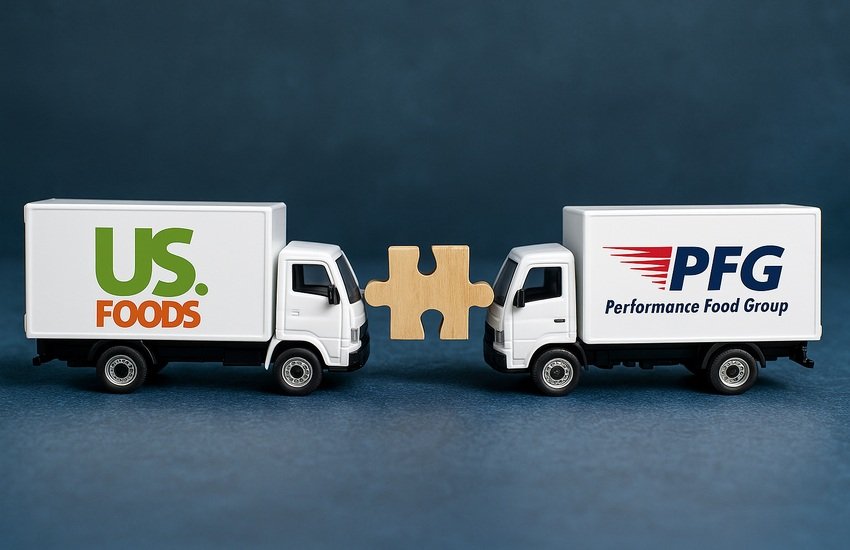Continue Reading With Our 7-Day Free Trial
Performance Food Group (PFG) has surged to the top of Wall Street chatter following reports that US Foods Holding Corp. is evaluating a potential acquisition of the company. According to people familiar with the matter, US Foods has expressed interest in merging with PFG in what would be a transformative deal for the food distribution industry. If completed, the combined entity would eclipse Sysco to become the largest foodservice distributor in the United States, commanding an estimated 18% market share of a $371 billion industry. Shares of Performance Food jumped as much as 6.2% on the news, closing with a market capitalization of roughly $14.8 billion, while US Foods ended flat with a market value of $18.6 billion. Though talks are still early and a deal is not guaranteed, the timing of this interest comes at a moment when Performance Food is reporting strong segmental resilience despite economic volatility and weather-related disruptions. US Foods, whose business heavily leans on restaurants, hotels, and healthcare, appears keen to consolidate its position through strategic exposure to higher-margin channels where PFG excels. Here’s why this tie-up could make strategic sense.
Complementary Market Exposure Across Independent and Convenience Channels
One of the strongest strategic rationales for US Foods acquiring Performance Food Group lies in the complementary nature of their customer bases. US Foods has historically focused on large-scale institutional customers such as chain restaurants, healthcare facilities, and educational institutions. Performance Food, on the other hand, has a stronghold in more fragmented yet resilient segments such as independent pizzerias, small restaurants, convenience stores, and snack distribution—areas where US Foods remains underexposed. According to the latest earnings call, PFG continues to generate strong organic independent case growth, particularly within its Foodservice and Core-Mark convenience divisions, even amid adverse weather and a mixed macroeconomic backdrop. For US Foods, the opportunity lies in acquiring a foothold in channels that have proven durable and margin-accretive during economic slowdowns. PFG’s Vistar (Specialty) segment also contributes to diversification by serving vending and office coffee channels, which benefit from return-to-work tailwinds. This breadth offers US Foods a means to hedge its exposure to volatility in chain restaurant demand while simultaneously expanding into underpenetrated but high-potential end markets. Such diversification would not only enhance top-line resilience but also strengthen cross-selling opportunities across distribution channels. Moreover, PFG’s proprietary brands and value offerings are tailored to independents—customers who often seek greater flexibility and differentiated service—which aligns well with evolving post-pandemic foodservice trends. For US Foods, this is less about overlap and more about plugging existing portfolio gaps through a meaningful adjacency expansion.
Synergies Through Procurement, Technology & Fleet Optimization
Performance Food Group’s growth trajectory has been bolstered by operational scale, technology deployment, and procurement leverage across its three major segments—Foodservice, Convenience, and Specialty. US Foods could unlock substantial synergies by integrating these capabilities with its existing operations. On the procurement front, PFG’s centralized buying power and supplier relationships, particularly strengthened post-acquisition of Cheney Brothers and Jose Santiago, have enabled favorable cost structures and gross margin expansion. By aligning purchasing programs, the combined company could realize cost efficiencies through vendor rationalization and volume discounts. Additionally, PFG’s technology investments in supply chain digitization, e-commerce, and efficiency software have improved delivery routes and productivity. For instance, its ability to ramp up sales force efficiency and execute logistics even during macro and weather challenges points to an advanced operational playbook that US Foods could benefit from replicating. Fleet optimization is another area ripe for synergy, given the combined footprint across over 70 US Foods locations and PFG’s extensive last-mile delivery infrastructure via Core-Mark. A unified routing and dispatch system could reduce overlapping routes and optimize fuel usage, particularly relevant as inflation and input costs remain volatile. Furthermore, the alignment of their back-end ERP systems and warehouse automation strategies may offer long-term SG&A leverage, especially as wage inflation pressures persist in the logistics-heavy distribution sector. Combined, these elements could pave the way for meaningful cost takeouts without compromising service levels or brand equity.
Market Leadership Potential & Strategic Scale Advantage Over Sysco
A merger between US Foods and Performance Food Group would create the largest foodservice distributor in the United States, surpassing current market leader Sysco Corporation. The combined company would command an estimated 18% of a fragmented $371 billion market, giving it strategic heft in negotiations with both suppliers and large-scale clients. Market leadership would be particularly advantageous in times of pricing pressure or commodity cost volatility, allowing the combined entity to drive category pricing, secure more favorable contracts, and invest in more advanced supply chain capabilities. Scale also matters in foodservice distribution, where density in delivery routes and warehouse proximity can significantly impact margins. The complementary geographic and segment coverage of US Foods and PFG could enable route density in underserved areas, while also allowing for the consolidation of underutilized distribution centers. Moreover, Sysco’s failed 2015 attempt to acquire US Foods—blocked by the Federal Trade Commission over antitrust concerns—suggests that this potential merger may walk a finer line but could be more palatable given the more diversified, non-overlapping footprint that PFG brings to the table. However, it’s worth noting that this scale could also trigger regulatory scrutiny, especially in markets where either party holds dominant share positions in certain product categories or regions. Nevertheless, in a landscape increasingly driven by just-in-time logistics and national account requirements, the ability to offer coast-to-coast service with superior scale could be a powerful moat against both regional players and digitally native disruptors.
Resilient Financial Performance & Cash Flow to Support Accretive Deal Structuring
From a financial standpoint, Performance Food Group has demonstrated resilient earnings growth and healthy cash flow generation—attributes that would be attractive to any strategic acquirer. In the fiscal third quarter of 2025, PFG reported 10.5% year-over-year net sales growth, driven by both organic volume increases and recent acquisitions. Adjusted EBITDA increased by 20.1% to $385.1 million, while free cash flow for the first nine months stood at $494 million. Notably, the company achieved gross profit growth of 16.2% in a challenging economic environment, reflecting strong operating leverage and margin control. These financial metrics are especially relevant to US Foods, whose own balance sheet and capital allocation strategy would be critical in structuring a potential acquisition. According to Bloomberg Intelligence, US Foods could structure the deal with a higher equity component to minimize debt pressure, keeping any leverage increase temporary. PFG’s ability to continue investing in its sales force, fleet, and capital projects while still reducing debt showcases a disciplined approach to capital management. Furthermore, the company’s history of integrating acquisitions like Core-Mark, Cheney Brothers, and Jose Santiago with synergy realization suggests a pragmatic culture that could mesh well with US Foods’ operational discipline. For US Foods, acquiring a financially solid, execution-focused peer like PFG may provide accretive earnings potential while also lowering integration risk compared to more distressed targets. That said, a large-scale merger would require careful scenario modeling given interest rate volatility, inflation risks, and uncertain consumer trends.
Key Takeaways
The potential acquisition of Performance Food Group by US Foods offers compelling strategic, financial, and operational rationales. From diversifying customer exposure and unlocking procurement synergies to challenging Sysco’s dominance and adding a financially robust operator, PFG presents itself as a strong complementary target. However, the path forward is far from clear. Regulatory hurdles loom large given the sector’s history with blocked deals, and macroeconomic uncertainty may alter buyer appetite or deal structure. While PFG’s recent earnings strength and market share gains reinforce its standalone value, they also elevate expectations around acquisition pricing and integration success. Whether the two firms proceed remains to be seen, but the underlying logic reflects a broader consolidation trend within the foodservice distribution industry—one increasingly defined by scale, margin resiliency, and diversified end-market reach.





